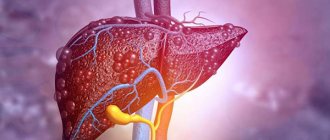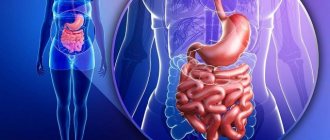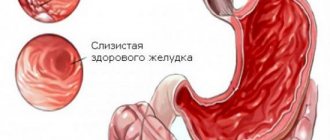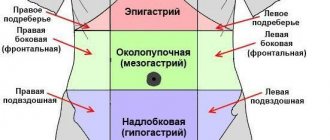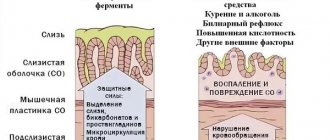The disease is treated by: Pediatric gastroenterologist
- Gastritis in a child: symptoms and treatment
- Causes of the disease
- Diagnosis of acute and chronic forms of the disease in children
- Features of acute gastritis
- Features of the chronic form of the disease
- How to treat gastritis in children?
- Diet features
Gastritis is a disease characterized by various inflammations of the gastric mucosa. Each type of disease has its own symptoms, therefore, knowing them, you can even externally determine the type of gastritis - chronic or acute.
Gastritis in a child: symptoms and treatment
Common symptoms include:
- heaviness and discomfort in the stomach, combined with or without pain;
- pain in the upper abdomen, which can be mild or very severe - this parameter depends on the child’s pain threshold and the intensity of inflammation;
- decreased appetite or complete refusal to eat;
- heartburn, which worsens with exercise and bending over and can spread through the esophagus;
- belching of food or air, which may be accompanied by an unpleasant odor;
- bloating, constipation, hypovitaminosis and other digestive disorders;
- nausea;
- vomit;
- pain when palpating the stomach area;
- pale skin, white or gray coating on the tongue (indirect signs).
Signs of chronic atrophic gastritis in children:
- heaviness in the stomach;
- digestive dysfunction;
- anemia;
- deficiency of vitamins in the body.
Symptoms of acute gastritis in children:
- vomiting (if it lasts for a very long time, lethargy occurs);
- constant pain;
- poor general health.
Hyperacid chronic gastritis manifests itself:
- pain;
- sour belching;
- heartburn;
- pain in the stomach;
- stomach upsets.
Children of the first year of life
Infants most often encounter functional gastrointestinal disorders such as acute and chronic diarrhea, intestinal dysbiosis, acute and chronic enterocolitis . Such disorders may be caused by congenital abnormalities of the large and small intestines, artificial feeding using formula that is not suitable for the child, early introduction of complementary foods, as well as the penetration of infectious pathogens of a bacterial or viral nature. Treatment of symptoms of enterocolitis in children is carried out only after the exact cause of the development of the pathology has been established.
Chronic and acute diarrhea, caused by an imbalance of intestinal microflora or infection, poses a direct threat not only to the health, but also to the life of the baby. If we talk about how to restore the child’s intestinal microflora, then in this situation we cannot do without probiotics and prebiotics.
Causes of the disease
Most often , gastritis of any form occurs in schoolchildren . The age from 6 to 17 years is a period of active development and growth, which creates favorable factors for damage to the body. Reasons include:
- unhealthy diet (chips, fast food, carbonated drinks, fatty and spicy foods, smoked foods). This is the most common cause of gastritis;
- eating spoiled food containing harmful microorganisms;
- lack of system in eating - irregular meals with long intervals and excessively large portions;
- excessive physical activity;
- lack of physical activity;
- psycho-mental excessive stress at school, lack of rest, leading to impaired production of gastric juice, poor appetite;
- damage by infections and/or toxins;
- general allergic reactions.
What can you feed your baby?
Diet for gastritis for children is no less important than medications. It allows you to protect the surface of the stomach from additional irritation, facilitate digestion, and achieve a long period of remission in a chronic process.
Basic nutritional requirements:
- Regular feeding 5-6 times a day in small portions. Compliance with the regime will allow you to “train” the secretory glands of the stomach to work actively.
- All products must be of good quality and gentle on the gastric mucosa. It is recommended to prepare the dishes on the planned menu before eating and not store them in the refrigerator for a long time. Spicy, fatty meat products and baked goods, smoked sausages, canned food, marinades, fresh bread, sauces and spices, sweets (chocolate, jam, candy, pastries and cake), legumes, and raw vegetable salads are strictly contraindicated.
- It is necessary to follow the cooking technology. Frying is not allowed; you can stew, boil, bake or use a double boiler. Dishes that are mushy, crushed, and not hot are suitable.
- Recommended vegetable or potato purees, soups with low-fat meat or fish broth, porridge with butter (oatmeal, buckwheat, rice), steamed cutlets, meatballs, meatballs, casserole with cottage cheese. Drinks include weak tea, coffee with milk, and decoctions of dried fruits. You can add honey to sweeten it.
Diagnosis of acute and chronic forms of the disease in children
The reason for the need for examination is the child’s complaints and external manifestations of the disease. The diagnosis can be confirmed or refuted by fibrogastroduodenoscopy. It is important to remember that the symptoms of gastritis are similar to other diseases that can be more dangerous.
During an examination using endoscopic technology, the doctor examines the gastric mucosa. Based on this, a conclusion is made about the child’s condition and treatment is prescribed. Source: L. N. Tsvetkova [et al.] Gastroenterological pathology in children: pathomorphosis of diseases and improvement of diagnostic methods at the present stage // Materials of the XVIII Congress of Pediatric Gastroenterologists, 2011, p. 5-8
This study presents challenges with young children. Therefore, fibrogastroduodenoscopy is not indicated for everyone. Children most often undergo general preventive treatment, based on the effectiveness of which a conclusion is made about the presence of the disease. If the symptoms do not go away during treatment, an endoscopic examination is performed, as there are direct indications for it - the possible presence of a more serious illness.
To exclude other digestive diseases, an ultrasound is also prescribed.
To determine the degree of gastritis and the presence of complications, laboratory diagnostics are performed:
- clinical blood test;
- general urine analysis;
- identifying the level of diastase;
- liver tests;
- fecal analysis for helminths.
Treatment of gastritis
Gastritis is a gastrointestinal disease, the key aspect of treatment of which remains diet.
The child should eat often, but in fractional portions. Fried, fatty foods, smoked foods, spicy seasonings, and marinades are temporarily excluded. All food must be boiled or steamed. It is recommended to feed the child pureed foods to minimize mechanical irritation of the gastric mucosa. Medication correction of the baby’s well-being is achieved using the following groups of drugs:
- proton pump inhibitors (Pantoprazole, Omeprazole), which reduce acidity;
- enveloping drugs - Almagel, Gaviscon;
- antibiotics (Metronidazole, Clarithromycin) are used to identify H. Pylori or other pathogenic bacteria.
In case of serious complications (bleeding, perforation, etc.), surgical intervention may be required.
Prevention of gastritis of any etiology involves eating well-heat-treated food in fractional portions. It is recommended not to abuse fast food. But the main thing is regular, nutritious meals. Gastritis is often also called “students’ disease” due to constant dry snacks. “SM-Doctor” is an advanced medical center that provides a full package of diagnostic and therapeutic services to patients with various forms of gastritis. The sooner the child begins to receive adequate treatment, the faster he will recover.
Features of acute gastritis
Inflammation of the mucous membrane appears due to negative external factors: poor nutrition, infections, consumption of expired products. Children can swallow substances containing toxins and poisons: household chemicals, drugs for adults, etc. They provoke irritation or burns of the mucous membrane, as a result, acute inflammation occurs.
Depending on the degree of damage to the mucous membrane, gastritis has varying degrees of severity and symptoms:
- with superficial inflammation, one-time vomiting and stomach pain occur;
- with deep inflammation, prolonged vomiting and stomach pain appear;
- when superficial erosions form due to inflammation, severe pain, prolonged vomiting, and general weakness appear;
- deep destruction and inflammation provoke similar, but very severe symptoms with dehydration against the background of incessant vomiting.
The first degree of the disease does not pose a threat and goes away without a trace with proper treatment. The second to fourth require specialized help because they can provoke gastric bleeding, dehydration, and intoxication.
Chronic gastritis
According to the causes of chronic gastritis, there are:
- Primary (exogenous). As an independent disease.
- Secondary (endogenous). As one of the manifestations of other somatic pathologies.
By localization:
- Focal (fundal). When it affects the bottom of the stomach;
- Common. Affects several sections, most or all of the stomach (pangastritis);
- Combined (gastroduodenitis). It causes inflammation of the stomach and duodenum.
With the flow:
- Latent (hidden, asymptomatic);
- Monotonous (symptoms are always present);
- Recurrent (alternate periods of exacerbations and remissions).
By stages (phases) of the process:
- Exacerbation (severe symptoms);
- Incomplete clinical remission (unexpressed symptoms, inflammation of the stomach is visible during FGDS);
- Clinical remission (there are no symptoms, but during FGDS inflammation of the mucous membrane is detected);
- Clinical and endoscopic remission (no symptoms, no traces of inflammation during instrumental examination).
According to changes in the mucous membrane:
- Superficial (without atrophy);
- Hypertrophic (with the growth of the mucous membrane, the formation of cysts and polyps);
- Hemorrhagic (tendency to bleeding from the walls of the stomach);
- Erosive (with the formation of stomach ulcers);
- Subatrophic (slow small-focal atrophy);
- Atrophic;
- Mixed.
Features of the chronic form of the disease
This type of disease lasts a long time , the symptoms are mild, and exacerbations occur periodically. It occurs due to disturbances in the activity and properties of the gastric mucosa: a lot of gastric juice is produced, which subsequently stagnates. As a result, the mucous membrane digests itself, and irritation occurs.
Rarely in children there is a form in which the cells of the mucous membrane are destroyed, the function of producing gastric juice, on the contrary, is reduced.
About the disease
Gastritis is one of the most common diseases of the gastrointestinal tract (GIT), which occurs more often in children, starting from school age.
The disease is characterized by the formation of a focus of inflammation in the gastric mucosa. This is how characteristic clinical symptoms appear, which can be provoked by both external and internal causes. The pathology can be acute or chronic. The danger of the disease lies in the disruption of digestive function and the possible development of serious complications that worsen the patient’s quality of life. If left untreated, gastritis progresses from childhood into adulthood.
How to treat gastritis in children?
The treatment methodology depends on the form of gastritis in children: chronic or acute.
Treatment of acute gastritis:
- gastric lavage;
- taking sorbents or gastrocytoprotective drugs;
- taking enzymes;
- taking medications to reduce the production of gastric secretions (if the disease lasts);
- diet;
- taking antispasmodics for severe pain.
Treatment of chronic gastritis:
- in case of excessive production of gastric juice, antisecretory therapy is carried out;
- if Helicobacter pylori is detected, antibacterial drugs are prescribed;
- taking antacids;
- taking antispasmodics for severe pain;
- taking medications to normalize intestinal and gastric motility;
- taking enzymes;
- for atrophy, vitamins and iron supplements are prescribed;
- treatment with mineral waters;
- Spa treatment.
Diagnosis of childhood gastritis
Diagnostics must be comprehensive. The patient's complaints and clinical picture allow a preliminary diagnosis of gastritis to be made. If this disease is suspected, a number of laboratory and instrumental studies are carried out:
- Fibrogastroduodenoscopy is the most informative research method, technically difficult, especially in children. An endoscope is inserted into the stomach cavity - a flexible instrument with fiber optics, with which the mucous membrane is visualized. This makes it possible to fully evaluate its structure. At the same time, a biopsy is performed - taking a sample of stomach tissue for further histological examination.
- Fractional sensing . It is used to study gastric contents, which are aspirated using a special probe. The level of hydrochloric acid secretion is determined, which makes it possible to differentiate between hyperacid and hypoacid gastritis.
- pH-metry is used for the same purpose, but the analysis of secretory activity is carried out directly inside the organ. To do this, a probe with a sensor is inserted, which remains in the stomach for some time. To obtain objective data, a histamine test is used to assess stimulated secretion.
- Ultrasound (ultrasound) is performed to exclude other pathologies (pancreatitis, hepatitis, biliary dyskinesia, etc.).
- A stool test is performed to identify helminthic infestations or occult blood.
- Blood and urine analysis . The blood is examined to rule out anemia and possible bleeding in the child. The main criteria here will be the level of red blood cells and hemoglobin.
Diet features
Proper nutrition is the key to minimizing relapses of gastritis.
- Regular fractional meals in equal portions.
- Only high-quality food, freshly prepared.
- Lack of fatty, spicy, smoked, fried foods containing a lot of spices and additives, raw vegetables, buns, legumes.
- Eating steamed or boiled foods.
- The presence in the menu of cereals, mashed potatoes, chicken, lean meat and fish, weak tea, cocoa with milk, honey, crackers, etc. on the recommendation of a doctor.
Functional disorders of the gastrointestinal tract in infants: the role of diet therapy
Functional disorders of the gastrointestinal tract (GIT) are one of the most widespread problems among children in the first months of life [1]. A distinctive feature of these conditions is the appearance of clinical symptoms in the absence of any organic changes in the gastrointestinal tract (structural abnormalities, inflammatory changes, infections or tumors) and metabolic abnormalities. With functional disorders of the gastrointestinal tract, motor function, digestion and absorption of nutrients, as well as the composition of the intestinal microbiota and the activity of the immune system may change [2–4]. The causes of functional disorders often lie outside the affected organ and are caused by a violation of the nervous and humoral regulation of the digestive tract.
In accordance with the Rome III criteria, proposed by the Committee on the Study of Functional Disorders in Children and the International Working Group on the Development of Criteria for Functional Disorders in 2006 [5], functional disorders of the gastrointestinal tract in infants and children of the second year of life include:
- G1. Regurgitation in babies.
- G2. Rumination syndrome in infants.
- G3. Cyclic vomiting syndrome.
- G4. Newborn colic.
- G5. Functional diarrhea.
- G6. Painful and difficult bowel movements (dyschezia) in infants.
- G7. Functional constipation.
In infants, especially the first 6 months of life, the most common conditions are regurgitation, intestinal colic and functional constipation. In more than half of children they are observed in various combinations, less often - as one isolated symptom. Since the causes leading to functional disorders affect various processes in the gastrointestinal tract, the combination of symptoms in one child seems quite natural. Thus, after hypoxia, vegetative visceral disorders may occur with changes in motility of the hyper- or hypotonic type and disturbances in the activity of regulatory peptides, leading simultaneously to regurgitation (as a result of spasm or gaping of the sphincters), colic (disturbances in gastrointestinal motility with increased gas formation) and constipation (hypotonic or due to intestinal spasm). The clinical picture is aggravated by symptoms associated with impaired digestion of nutrients, caused by a decrease in the enzymatic activity of the affected enterocyte, and leading to changes in the intestinal microbiocenosis [6].
The causes of functional disorders of the gastrointestinal tract can be divided into two groups: those associated with the mother and those associated with the child.
The first group of reasons include:
- complicated obstetric history;
- emotional lability of a woman and a stressful situation in the family;
- errors in nutrition in a nursing mother;
- violation of feeding technique and overfeeding during natural and artificial feeding;
- improper dilution of infant formula;
- woman smoking.
Child related reasons include:
- anatomical and functional immaturity of the digestive organs (short abdominal esophagus, sphincter insufficiency, reduced enzymatic activity, uncoordinated work of the gastrointestinal tract, etc.);
- dysregulation of the gastrointestinal tract due to immaturity of the central and peripheral nervous system (intestines);
- features of the formation of intestinal microbiota;
- formation of the sleep/wake rhythm.
The most common and most serious causes leading to regurgitation, colic and stool disturbances are hypoxia (vegetovisceral manifestations of cerebral ischemia), partial lactase deficiency and the gastrointestinal form of food allergy. Often, to varying degrees of severity, they are observed in one child, since the consequences of hypoxia are a decrease in enzyme activity and an increase in the permeability of the small intestine.
Regurgitation is the spontaneous reflux of gastric contents into the esophagus and oral cavity.
The frequency of regurgitation syndrome in children of the first year of life, according to a number of researchers, ranges from 18% to 50% [7, 8]. Mostly regurgitation is observed in the first 4–5 months of life, much less frequently observed at the age of 6–7 months, after the introduction of thicker food - complementary foods, practically disappearing by the end of the first year of life, when the child spends a significant part of the time in an upright position (sitting or standing).
The severity of regurgitation syndrome, according to the recommendations of the ESPGHAN expert group, is proposed to be assessed on a five-point scale, reflecting the overall characteristics of the frequency and volume of regurgitation (Table 1).
Infrequent and mild regurgitation is not regarded as a disease, since it does not cause changes in the health of children. Children with persistent regurgitation (score from 3 to 5 points) often experience complications such as esophagitis, retardation in physical development, iron deficiency anemia, and diseases of the ENT organs. Clinical manifestations of esophagitis are decreased appetite, dysphagia and hoarseness.
The next most common functional gastrointestinal disorder in infants is intestinal colic - these are episodes of painful crying and restlessness of the child, which take at least 3 hours a day, occurring at least 3 times a week. Usually their debut occurs at 2–3 weeks of life, culminates in the second month, gradually disappearing after 3–4 months. The most typical time for intestinal colic is the evening hours. Crying attacks arise and end suddenly, without any external provoking reasons [9].
The frequency of intestinal colic, according to various sources, ranges from 20% to 70% [9, 10]. Despite a long period of study, the etiology of intestinal colic remains not entirely clear.
Intestinal colic is characterized by sharp painful crying, accompanied by redness of the face, the child takes a forced position, pressing his legs to his stomach, and difficulties arise with the passage of gases and stool. Noticeable relief occurs after defecation.
Episodes of intestinal colic cause serious concern for parents, even if the child’s appetite is not impaired, he has normal weight curves, grows and develops well.
Intestinal colic occurs with almost the same frequency in both natural and artificial feeding. It is noted that the lower the birth weight and gestational age of the child, the higher the risk of developing this condition.
In recent years, much attention has been paid to the role of intestinal microflora in the occurrence of colic. Thus, in children with these functional disorders, changes in the composition of the intestinal microbiota are detected, characterized by an increase in the number of opportunistic microorganisms and a decrease in the protective flora - bifidobacteria and especially lactobacilli [11, 12]. Increased growth of proteolytic anaerobic microflora is accompanied by the production of gases with potential cytotoxicity. In children with severe intestinal colic, the level of the inflammatory protein calprotectin often increases [13].
Functional constipation is one of the most common disorders of intestinal function and is detected in 20–35% of children in the first year of life [14, 15].
Constipation is understood as an increase in the intervals between bowel movements compared to the individual physiological norm for more than 36 hours and/or systematically incomplete bowel movement.
The frequency of stool in children is considered normal if, from 0 to 4 months of age, there are from 7 to 1 bowel movements per day, from 4 months to 2 years, from 3 to 1 bowel movement. Defecation disorders in infants also include dyschezia - painful defecation caused by dyssynergia of the pelvic floor muscles, and functional stool retention, which is characterized by an increase in the intervals between bowel movements, combined with feces of soft consistency, large diameter and volume.
In the mechanism of development of constipation in infants, the role of colon dyskinesia is significant. The most common cause of constipation in children of the first year of life is nutritional disorders.
The absence of a clearly defined boundary between functional disorders and pathological conditions, as well as the presence of long-term consequences (chronic inflammatory gastroenterological diseases, chronic constipation, allergic diseases, sleep disorders, disorders in the psycho-emotional sphere, etc.) dictate the need for a careful approach to the diagnosis and treatment of these conditions.
Treatment of infants with functional disorders of the gastrointestinal tract is complex [3, 16] and includes a number of successive stages, which are:
- outreach and psychological support to parents;
- diet therapy;
- drug therapy (pathogenetic and syndromic);
- non-drug treatment: therapeutic massage, exercises in water, dry immersion, music therapy, aromatherapy, aeroion therapy.
The presence of regurgitation dictates the need to use symptomatic positional (postural) therapy - changing the position of the child’s body, aimed at reducing the degree of reflux and helping to clear the esophagus of gastric contents, thereby reducing the risk of esophagitis and aspiration pneumonia. The baby should be fed in a sitting position, with the baby's body positioned at an angle of 45–60°. After feeding, it is recommended to hold the baby in an upright position for a sufficiently long time, until the air leaves, for at least 20–30 minutes. Postural treatment must be carried out not only throughout the day, but also at night, when the clearing of the lower esophagus from aspirate is impaired due to the absence of peristaltic waves (caused by the act of swallowing) and the neutralizing effect of saliva.
The leading role in the treatment of functional disorders of the gastrointestinal tract in children belongs to therapeutic nutrition. The purpose of diet therapy primarily depends on the type of feeding of the child.
When breastfeeding, first of all, it is necessary to create a calm environment for the nursing mother, aimed at maintaining lactation, to normalize the child’s feeding regimen, excluding overfeeding and aerophagia. Foods that increase gas formation in the intestines (sweets: confectionery, tea with milk, grapes, curd spreads and cheeses, non-alcoholic sweet drinks) and rich in extractive substances (meat and fish broths, onions, garlic, canned food, marinades, pickles) are excluded from the mother’s diet. , sausages).
According to some authors, functional disorders of the gastrointestinal tract can arise as a result of food intolerance, most often an allergy to cow's milk proteins. In such cases, the mother is prescribed a hypoallergenic diet; whole cow's milk and foods with a high allergenic potential are excluded from her diet.
In the process of organizing diet therapy, it is necessary to exclude overfeeding of the child, especially with free feeding.
If there is no effect from the measures described above, for persistent regurgitation, “thickeners” (for example, Bio-rice broth) are used, which are diluted with breast milk and given from a spoon before breastfeeding.
It must be remembered that even severe functional disorders of the gastrointestinal tract are not an indication for transferring a child to mixed or artificial feeding. The persistence of symptoms is an indication for additional in-depth examination of the child.
When artificial feeding, it is necessary to pay attention to the child’s feeding regimen, to the adequacy of the choice of milk formula that corresponds to the functional characteristics of his digestive system, as well as its volume. It is advisable to introduce into the diet adapted dairy products enriched with pre- and probiotics, as well as fermented milk mixtures: Agusha fermented milk 1 and 2, NAN Fermented milk 1 and 2, Nutrilon fermented milk, Nutrilak fermented milk. If there is no effect, products specially created for children with functional gastrointestinal disorders are used: NAN Comfort, Nutrilon Comfort 1 and 2, Frisov 1 and 2, Humana AR, etc.
If the disorders are caused by lactase deficiency, the child is gradually introduced to lactose-free mixtures. For food allergies, specialized products based on highly hydrolyzed milk protein may be recommended. Since one of the causes of regurgitation, colic and stool disturbances are neurological disorders due to perinatal damage to the central nervous system, dietary correction should be combined with drug treatment, which is prescribed by a pediatric neurologist.
Both with artificial and natural feeding, it is advisable to offer the child baby drinking water between feedings, especially if he is prone to constipation.
Children with regurgitation syndrome deserve special attention. If there is no effect from the use of standard milk formulas, it is advisable to prescribe anti-reflux products (AR mixtures), the viscosity of which increases due to the introduction of specialized thickeners into their composition [17, 18]. For this purpose, two types of polysaccharides are used:
- indigestible (gums that form the basis of locust bean gluten (CLG));
- digestible (rice or potato starches) (Table 2).
CRP is, of course, an interesting component in baby food products, and I would like to dwell on its properties in more detail. The main physiologically active component of CRD is the polysaccharide galactomannan. It belongs to the group of dietary fibers and performs two interrelated functions. In the stomach cavity, KRD provides a more viscous consistency of the mixture and prevents regurgitation. At the same time, CRF is a non-degradable but fermentable dietary fiber, which gives this compound classic prebiotic properties.
The term “non-degradable dietary fiber” refers to its resistance to the effects of pancreatic amylase and small intestinal disacchidases. The concept of “fermentable dietary fiber” reflects their active fermentation by beneficial microflora of the colon, primarily bifidobacteria. As a result of such fermentation, a number of physiological effects important for the body occur, namely:
- the content of bifidobacteria in the colon cavity increases (tens of times);
- during the fermentation process, metabolites are formed - short-chain fatty acids (acetic, butyric, propionic), which promote a shift in pH to the acidic side and improve the trophism of intestinal epithelial cells;
- Due to the growth of bifidobacteria and a change in the pH of the environment towards the acidic side, conditions are created for the suppression of opportunistic intestinal microflora and the composition of the intestinal microbiota improves.
The positive effect of CRD on the composition of the intestinal microflora in children of the first year of life has been described in a number of studies [19]. This is one of the important aspects of the use of modern AR mixtures in pediatric practice.
Mixtures containing KRD (gum) also have a proven clinical effect for functional constipation. An increase in the volume of intestinal contents due to the development of beneficial intestinal microflora, a change in the pH of the environment towards the acidic side and moistening of the chyme contribute to increased intestinal motility. An example of such mixtures are Frisov 1 and Frisov 2. The first is intended for children from birth to 6 months, the second - from 6 to 12 months [20]. These mixtures can be recommended either in full or in part, in an amount of 1/3–1/2 of the required volume at each feeding, in combination with a regular adapted milk formula, until a lasting therapeutic effect is achieved.
Another group of AR mixtures are products that include starches as a thickener, which act only in the upper gastrointestinal tract, and a positive effect occurs when they are used in full. These mixtures are indicated for children with less pronounced regurgitation (1–3 points), both with normal stool and with a tendency to loose stool. Among the products in this group, the NAN Antireflux mixture stands out, which has double protection against regurgitation: due to a thickener (potato starch), which increases the viscosity of gastric contents and moderately hydrolyzed protein, which increases the rate of gastric emptying and additionally prevents constipation.
Currently, an updated anti-reflux mixture, Humana AR, has appeared on the Russian consumer market, which simultaneously contains locust bean gum (0.5 g) and starch (0.3 g), which makes it possible to enhance the functional effect of the product.
Despite the fact that AR formulas are complete in composition and are designed to meet the child’s physiological needs for nutrients and energy, according to international recommendations they belong to the group of baby food products “for special medical purposes.” Therefore, products in this group should be used strictly when clinically indicated, on the recommendation of a physician and under medical supervision. The duration of use of AR mixtures should be determined individually and can be quite long, about 2–3 months. Transfer to an adapted milk formula is carried out after achieving a stable therapeutic effect.
Literature
- Belyaeva I. A., Yatsyk G. V., Borovik T. E., Skvortsova V. A. Integrated approaches to the rehabilitation of children with gastrointestinal dysfunctions // Issues. modern ped. 2006; 5 (3): 109–113.
- Frolkis A.V. Functional diseases of the gastrointestinal tract. L.: Medicine, 1991, 224 p.
- Functional disorders of the gastrointestinal tract in infants and their dietary correction. In the book: National program for optimizing the feeding of children in the first year of life in the Russian Federation. Union of Pediatricians of Russia, M., 2010, 39–42.
- Zakharova I. N. Regurgitation and vomiting in children: what to do? // Consilium medicum. Pediatrics. 2009, No. 3, p. 16–0.
- Hyman PE, Milla PJ, Bennig MA et al. Childhood functional gastrointestinal disorders: neonate/toddler // Am.J. Gastroenterol. 2006, v. 130 (5), p. 1519–1526.
- Khavkin A.I. Principles of selection of diet therapy for children with functional disorders of the digestive system // Children's gastroenterology. 2010, vol. 7, no. 3.
- Khorosheva E.V., Sorvacheva T.N., Kon I.Ya. Regurgitation syndrome in infants // Nutrition Issues. 2001; 5:32–34.
- Kon I. Ya., Sorvacheva T. N. Diet therapy for functional disorders of the gastrointestinal tract in children of the first year of life // Attending Physician. 2004, No. 2, p. 55–59.
- Samsygina G. A. Algorithm for the treatment of childhood intestinal colic // Consilium medicum. Pediatrics. 2009. No. 3. P. 55–67.
- Kornienko E. A., Wagemans N. V., Netrebenko O. K. Infantile intestinal colic: modern ideas about the mechanisms of development and new possibilities for therapy. St. Petersburg state ped. honey. Academy, Nestlé Nutrition Institute, 2010, 19 p.
- Savino F., Cresi F., Pautasso S. et al. Intestinal microflora in colicky and non-colicky infants // Acta Pediatrica. 2004, v. 93, p. 825–829.
- Savino F., Bailo E., Oggero R. et al. Bacterial counts of intestinal Lactobacillus species in infants with colic // Pediatr. Allergy Immunol. 2005, v. 16, p. 72–75.
- Rhoads JM, Fatheree NJ, Norori J. et al. Altered fecal microflora and increased fecal calprotectin in infant colic // J. Pediatr. 2009, v. 155 (6), p. 823–828.
- Sorvacheva T.N., Pashkevich V.V., Kon I.Ya. Diet therapy for constipation in children of the first year of life. In the book: Guide to baby nutrition (edited by V. A. Tutelyan, I. Ya. Kon). M.: MIA, 2009, 519–526.
- Korovina N. A., Zakharova I. N., Malova N. E. Constipation in young children // Pediatrics. 2003, 9, 1–13.
- Functional disorders of the gastrointestinal tract in infants and their dietary correction. In the book: Therapeutic nutrition of children in the first year of life (under the general editorship of A. A. Baranov and V. A. Tutelyan). Clinical guidelines for pediatricians. M.: Union of Pediatricians of Russia, 2010, p. 51–64.
- Clinical dietetics of childhood. Ed. T. E. Borovik, K. S. Ladodo. M.: MIA, 2008, 607 p.
- Belmer S.V., Khavkin A.I., Gasilina T.V. et al. Regurgitation syndrome in children of the first year. A manual for doctors. M.: RGMU, 2003, 36 p.
- Anokhin V.A., Khasanova E.E., Urmancheeva Yu.R. et al. Evaluation of the clinical effectiveness of Frisov’s mixture in the nutrition of children with intestinal dysbiosis of varying degrees and minimal digestive dysfunctions // Issues of modern pediatrics. 2005, 3: 75–79.
- Gribakin S.G. Antireflux mixtures Frisov 1 and Frisov 2 for functional disorders of the gastrointestinal tract in children // Pediatric practice. 2006; 10:26–28.
T. E. Borovik*, Doctor of Medical Sciences, Professor V. A. Skvortsova*, Doctor of Medical Sciences G. V. Yatsyk*, Doctor of Medical Sciences, Professor N. G. Zvonkova*, Candidate of Medical Sciences S. G. Gribakin* *, Doctor of Medical Sciences, Professor *SCDC RAMS, **RMAPO, Moscow
Contact information for authors for correspondence
Advantages of SM-Clinic
In our medical center you will find some of the best gastroenterologists in the city for the diagnosis and treatment of childhood gastritis of all forms. We will quickly diagnose a child of any age, prescribe effective therapy, and provide the necessary consultations on nutrition and relapse prevention.
You can make an appointment by phone.
Sources:
- E. V. Savitskaya. Features of gastroduodenal pathology in children of preschool and primary school age // Suchasna gastroenterology, 2008, No. 3, p. 35-37.
- Yu.V. Belousov. Chronic atrophic gastritis in children // Clinical Pediatrics, 2011, 5 (32).
- L. N. Tsvetkova [and others]. Gastroenterological pathology in children: pathomorphosis of diseases and improvement of diagnostic methods at the present stage // Materials of the XVIII Congress of Children's Gastroenterologists, 2011, p. 5-8.
The information in this article is provided for reference purposes and does not replace advice from a qualified professional. Don't self-medicate! At the first signs of illness, you should consult a doctor.
Preschool children
The preschooler's body continues to be in its developing stages, and the immune system still remains immature. In addition, the diet of preschool children is significantly expanded compared to infants, which can cause the development of food allergies, as well as the following diseases of the gastrointestinal tract:
- Chronic constipation. Violation of the motor-evacuation function of the large intestine in a preschool child can be caused by abnormalities in the structure of intestinal loops, unbalanced nutrition, psychological problems and the use of certain groups of medications. Treatment of constipation in children 3 years of age and older is carried out using not only gentle laxatives, but also with the help of drugs that normalize the balance of intestinal microflora.
- Chronic gastritis. Violation of the diet and poor diet can provoke chronic inflammation of the stomach in a child. Often this condition develops as a result of Helicobacter pylori infection, which in adulthood also causes the development of gastritis and gastric ulcers.
- Chronic duodenitis. This condition is in addition to chronic gastritis.
Prices
| Name of service (price list incomplete) | Price |
| Appointment (examination, consultation) with a gastroenterologist, primary, therapeutic and diagnostic, outpatient | 1950 rub. |
| Prescription of treatment regimen (for up to 1 month) | 1800 rub. |
| Consultation (interpretation) with analyzes from third parties | 2250 rub. |
| Consultation with a candidate of medical sciences | 2500 rub. |
| Ultrasound of the abdominal organs (comprehensive) | 2900 rub. |
| Ultrasound of the retroperitoneal space (and retroperitoneal lymph nodes) | 1400 rub. |
| Ultrasound of the gallbladder | 1400 rub. |
| Ultrasound of the abdominal organs (comprehensive) | 2900 rub. |
| Ultrasound of the liver | 1600 rub. |
| Ultrasound of the spleen | 1600 rub. |
| Diagnosis of Helicobacter pylori infection (HELPIL test) | 1200 rub. |
| Colonoscopy | 5600 rub. |
| Biopsy during endoscopic examination (1 biopsy) | 1000 rub. |
| Body composition assessment - bioimpedance analysis | 2150 rub. |
| Body composition assessment - repeated (bioimpedance analysis) | 1750 rub. |
| Esophagogastroduodenoscopy (EFGDS) | 3500 rub. |
Diagnostic methods
It is important to find out the reasons for the child’s complaints through examination. Gastritis sometimes disguises other diseases. Fibrogastroduodenoscopy is the optimal way to examine the gastric mucosa and assess its condition, but in pediatrics it is used with difficulty, only for older children.
It is technically difficult for children to carry out. Therefore, they are first prescribed standard treatment according to the regimen and the condition is monitored. If the signs of the disease do not decrease, then fibrogastroduodenoscopy is considered absolutely indicated. Ultrasound and x-ray examinations are not used in children due to their low information content.
They may be needed to exclude chronic pancreatitis, hepatitis, and cholelithiasis. In the laboratory, the child is checked for signs of anemia (hemoglobin, the number of red blood cells in a general blood test), diastasis in the urine, and tests for liver biochemical parameters in the blood serum.
Be sure to prescribe a stool examination for scatology, occult blood and detection of worm infection.
